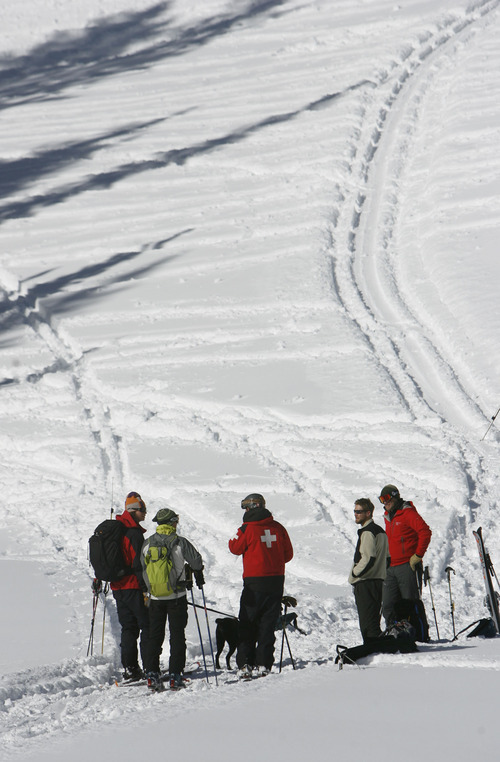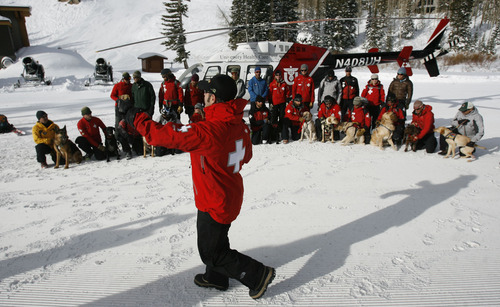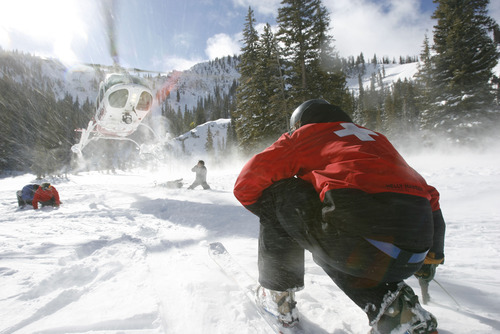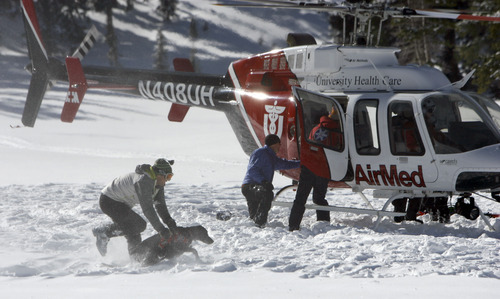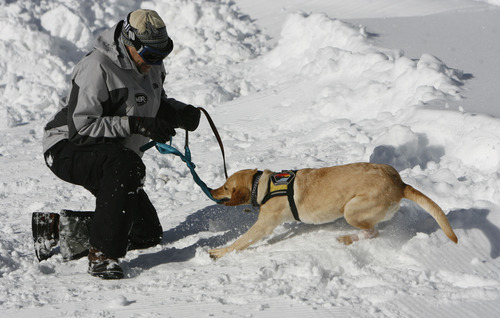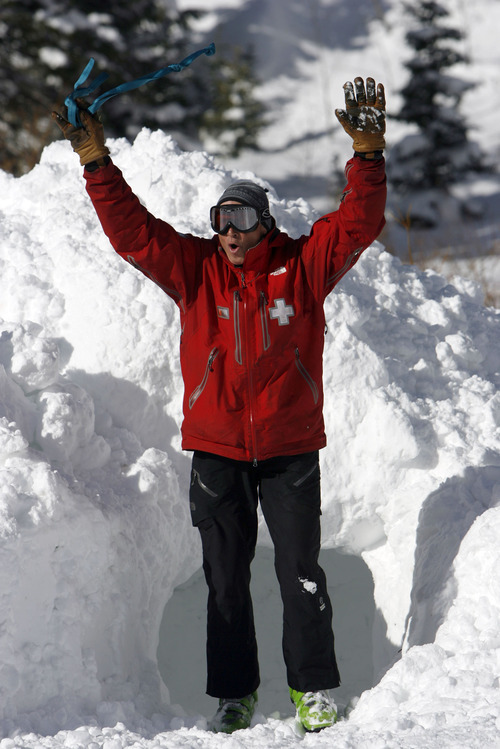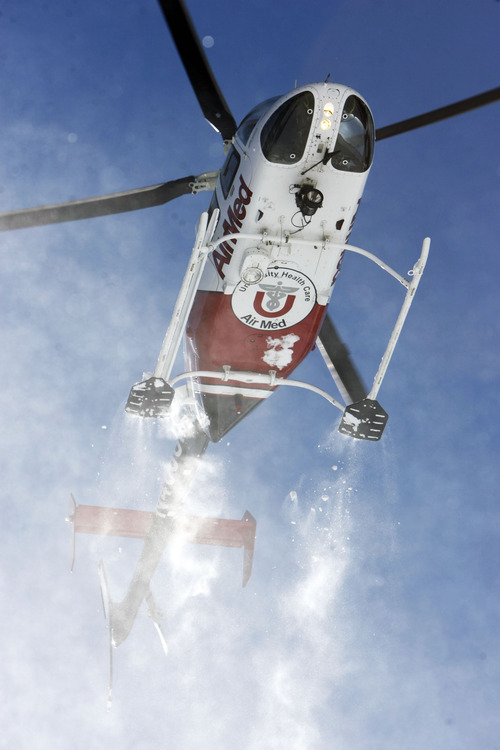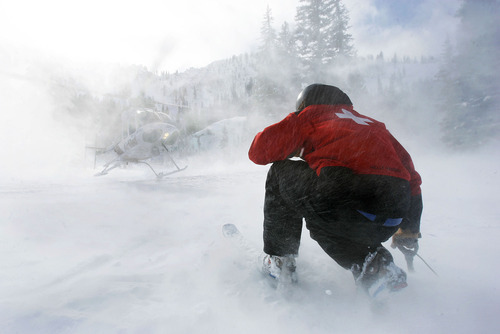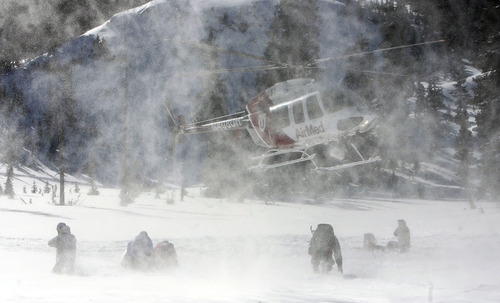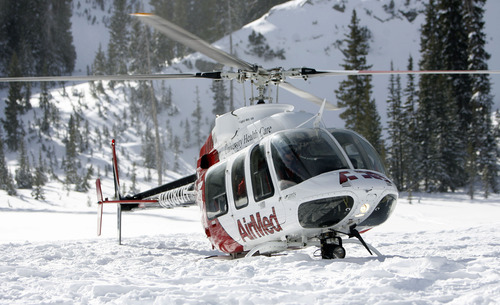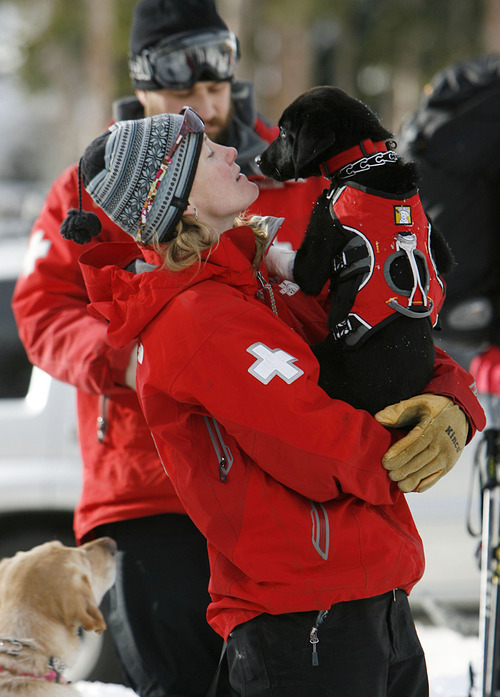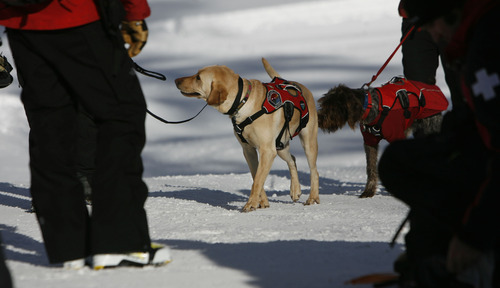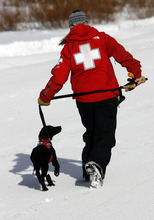Francisco Kjolseth | The Salt Lake Tribune
Local teams of highly-trained avalanche rescue dogs and their handlers gather at Brig
Francisco Kjolseth | The Salt Lake Tribune
Local teams of highly-trained avalanche rescue dogs and their handlers gather at Brig
Francisco Kjolseth | The Salt Lake Tribune
Andy VanHouten, right, with Park City search and rescue guides an AirMed chopper foll
Francisco Kjolseth | The Salt Lake Tribune
Lauren Edwards guides 4-month-old Tucker, an avalanche dog in training, for a victim
Francisco Kjolseth | The Salt Lake Tribune
A local highly-trained avalanche rescue dog unloads at Dog lake at Brighton at the to
Francisco Kjolseth | The Salt Lake Tribune
Marvin Sumner, ski patrol director at Brighton resort rewards Rio after finding a vic
Francisco Kjolseth | The Salt Lake Tribune
Paul Santana with the Canyon's search and rescue works with a young avalanche dog in
Francisco Kjolseth | The Salt Lake Tribune
An AirMed chopper takes off from Dog lake near Brighton resort after dropping off a l
Francisco Kjolseth | The Salt Lake Tribune
An AirMed chopper flies into Dog lake near Brighton resort to drop-off a local highly
Francisco Kjolseth | The Salt Lake Tribune
Andy VanHouten with Park City search and rescue guides an AirMed chopper dropping off
Francisco Kjolseth | The Salt Lake Tribune
An AirMed chopper flies into Dog lake near Brighton resort to drop-off a local highly
Francisco Kjolseth | The Salt Lake Tribune
An AirMed chopper sinks below the snow line with a partially turned bear claw on its
Francisco Kjolseth | The Salt Lake Tribune
Lauren Edwards, cuddles 4-month-old Tucker, an avalanche dog in training as she and o
Francisco Kjolseth | The Salt Lake Tribune
Local teams of highly-trained avalanche rescue dogs and their handlers gather at Brig
Francisco Kjolseth | The Salt Lake Tribune
Brandon Dodge, in charge of snow safety at Brighton resort guides a AirMed chopper as
Francisco Kjolseth | The Salt Lake Tribune
Local teams of highly-trained avalanche rescue dogs and their handlers gather at Brighton at the top of Big Cottonwood Canyon on Wednesday, January 25, 2012 near Dog lake so dogs could get experience flying to scene in a helicopter and then jumping into action to find a snow burried skier or boarder.The teams worked on avalanche victim search drills, beacon searches, helicopter training and classroom sessions conducted by Wasatch Backcountry Rescue (WBR).
Francisco Kjolseth | The Salt Lake Tribune
Local teams of highly-trained avalanche rescue dogs and their handlers gather at Brighton at the top of Big Cottonwood Canyon on Wednesday, January 25, 2012 for a group picture before starting avalanche victim search drills, beacon searches, helicopter training and classroom sessions conducted by Wasatch Backcountry Rescue (WBR).
Francisco Kjolseth | The Salt Lake Tribune
Andy VanHouten, right, with Park City search and rescue guides an AirMed chopper following a drop-off of a local highly-trained avalanche rescue dog team near Dog lake at Brighton at the top of Big Cottonwood Canyon on Wednesday, January 25, 2012 to do avalanche victim search drills, beacon searches and helicopter training conducted by Wasatch Backcountry Rescue (WBR).
Francisco Kjolseth | The Salt Lake Tribune
Lauren Edwards guides 4-month-old Tucker, an avalanche dog in training, for a victim search following a helicopter ride at Brighton resort on Wednesday, January 25, 2012. Local teams of highly-trained avalanche rescue dogs and their handlers gathered at Brighton to do avalanche victim search drills, beacon searches, helicopter training and classroom sessions conducted by Wasatch Backcountry Rescue (WBR).
Francisco Kjolseth | The Salt Lake Tribune
A local highly-trained avalanche rescue dog unloads at Dog lake at Brighton at the top of Big Cottonwood Canyon on Wednesday, January 25, 2012 to do avalanche victim search drills, beacon searches, helicopter training and classroom sessions conducted by Wasatch Backcountry Rescue (WBR).
Francisco Kjolseth | The Salt Lake Tribune
Marvin Sumner, ski patrol director at Brighton resort rewards Rio after finding a victim in a snow hole during training. Local teams of highly-trained avalanche rescue dogs and their handlers gather at Brighton at the top of Big Cottonwood Canyon on Wednesday, January 25, 2012 to do avalanche victim search drills, beacon searches, helicopter training and classroom sessions conducted by Wasatch Backcountry Rescue (WBR).
Francisco Kjolseth | The Salt Lake Tribune
Paul Santana with the Canyon's search and rescue works with a young avalanche dog in training as he excitedly throws his arms in the air to get its attention before jumping into a snow hole. Local teams of highly-trained avalanche rescue dogs and their handlers gather at Brighton at the top of Big Cottonwood Canyon on Wednesday, January 25, 2012 to do avalanche victim search drills, beacon searches, helicopter training and classroom sessions conducted by Wasatch Backcountry Rescue (WBR).
Francisco Kjolseth | The Salt Lake Tribune
An AirMed chopper takes off from Dog lake near Brighton resort after dropping off a local highly-trained avalanche rescue dog team on Wednesday, January 25, 2012 to do avalanche victim search drills, beacon searches and helicopter training conducted by Wasatch Backcountry Rescue (WBR).
Francisco Kjolseth | The Salt Lake Tribune
An AirMed chopper flies into Dog lake near Brighton resort to drop-off a local highly-trained avalanche rescue dog team on Wednesday, January 25, 2012 to do avalanche victim search drills, beacon searches and helicopter training conducted by Wasatch Backcountry Rescue (WBR).
Francisco Kjolseth | The Salt Lake Tribune
Andy VanHouten with Park City search and rescue guides an AirMed chopper dropping off a local highly-trained avalanche rescue dog team near Dog lake at Brighton at the top of Big Cottonwood Canyon on Wednesday, January 25, 2012 to do avalanche victim search drills, beacon searches and helicopter training conducted by Wasatch Backcountry Rescue (WBR).
Francisco Kjolseth | The Salt Lake Tribune
An AirMed chopper flies into Dog lake near Brighton resort to drop-off a local highly-trained avalanche rescue dog team on Wednesday, January 25, 2012 to do avalanche victim search drills, beacon searches and helicopter training conducted by Wasatch Backcountry Rescue (WBR).
Francisco Kjolseth | The Salt Lake Tribune
An AirMed chopper sinks below the snow line with a partially turned bear claw on its skid meant to keep it above snow prompting the pilot to take off again while transporting local teams of highly-trained avalanche rescue dogs and their handlers into the back country for training at Brighton resort on Wednesday, January 25, 2012.
Francisco Kjolseth | The Salt Lake Tribune
Lauren Edwards, cuddles 4-month-old Tucker, an avalanche dog in training as she and other local teams of highly-trained avalanche rescue dogs and their handlers gathered at Brighton at the top of Big Cottonwood Canyon on Wednesday, January 25, 2012 to do avalanche victim search drills, beacon searches, helicopter training and classroom sessions conducted by Wasatch Backcountry Rescue (WBR).
Francisco Kjolseth | The Salt Lake Tribune
Local teams of highly-trained avalanche rescue dogs and their handlers gather at Brighton at the top of Big Cottonwood Canyon on Wednesday, January 25, 2012 to do avalanche victim search drills, beacon searches, helicopter training and classroom sessions conducted by Wasatch Backcountry Rescue (WBR).
Francisco Kjolseth | The Salt Lake Tribune
Brandon Dodge, in charge of snow safety at Brighton resort guides a AirMed chopper as local teams of highly-trained avalanche rescue dogs and their handlers gathered at Brighton at the top of Big Cottonwood Canyon on Wednesday, January 25, 2012 for training. The teams worked on avalanche victim search drills, beacon searches, helicopter training and classroom sessions conducted by Wasatch Backcountry Rescue (WBR).


